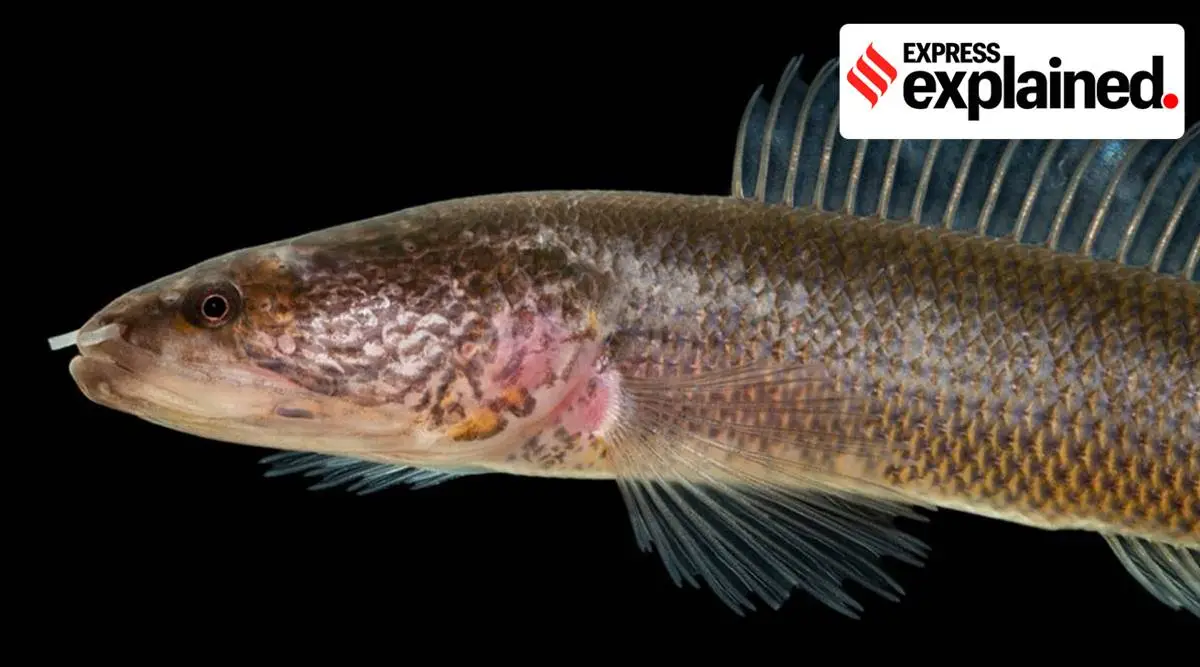Play all audios:
It looks like a dragon, swims like an eel, and has remained hidden for a hundred million years. After a social media post made a researcher in Kerala curious, a type of fish was discovered
in the watery underground rocks of the state that scientists have named “Gollum”, after the dark and conflicted character of JRR Tolkien’s epic saga ‘Lord of the Rings’. ‘Aenigmachanna
gollum’ belongs to an old family of fish, called dragon snakeheads, which retains its primitive characteristics after all these millennia. “These living fossils hold a prominent role for our
understanding of the diversification of the group in question,” wrote researchers Ralf Britz, Neelesh Dahanukar, VK Anoop, Siby Philip, Rajeev Raghavan, Brett Clark and Lukas Ruber in a
paper, titled ‘Aenigmachannidae, a new family of snakehead fishes (Teleostei: Channoidei) from subterranean waters of South’, on the open access nature.com a few weeks ago. Story continues
below this ad Besides the Gollum, a sister species has also been discovered, called ‘Aenigmachanna mahabali’. The scientists call the find one of the most exciting in the fish world of the
last decade. Here’s why. A RARE SIGHTING The discovery of a new family of fish is very rare. The dragon snakeheads have evaded scientists till now because they live in subterranean aquifers
and come to the surface only after heavy flooding from rain. The closest relative of the family Aenigmachannidae is the Channidae, of which at least 50 species can be found in the streams
and lakes of Asia and tropical Africa. According to molecular analyses, the two families split from each other 34 million to 109 million years ago. “This may indicate that Aenigmachanna is a
Gondwanan lineage, which has survived break-up of the supercontinent, with India separating from Africa at around 120 million years ago,” the researchers have said in the paper. Story
continues below this ad DON’T MISS FROM EXPLAINED | HOW ‘FILTHY’ IS INDIA, AND WHAT IS ECONOMIC COST OF BEING ‘FILTHY’ RELIC FROM ANOTHER TIME The lack of evolution can be seen in the
shortened swim bladder of the dragon snakeheads as well as fewer vertebrae with ribs. These indicate that the family is less specialised than regular snakeheads. The family also has eyes and
a reddish brown pigmentation, which is unusual as most subterranean fish are pale and have no eyes. Unlike the Channidae, the Aenigmachannidae also lack the suprabranchial organ that allows
the former to breathe air and proliferate widely. “Among the seemingly endless diversity of animal life on our planet, a few extant species hold a unique position for our understanding of
the evolution of the group to which they belong. Such taxa have previously been characterized with the term ‘living fossil’ starting with Darwin or have been referred to as ‘basal taxa’.
They exhibit a striking level of morphological stasis as evidenced by a surprisingly large number of primitive characters compared to their extant sister group, and often represent lineages
with only few extant representatives and a restricted distribution,” says the paper._📣 CLICK TO FOLLOW EXPRESS EXPLAINED ON TELEGRAM_ POWERED BY SOCIAL MEDIA Story continues below this ad It
is likely that the Gollum and Mahabali would have remained unknown for longer without the power of social media. At the beginning of 2018, Rajeev Raghavan, a fish researcher at Kerala
University of Fisheries and Ocean Studies and co-author of the present study, saw a post on social media of a curious fish that a person had found in a well in the backyard. He could not
recognise the creature and emailed the picture to Britz, who couldn’t understand it either. Raghavan and his colleagues started to collect more specimens of the fish for a scientific study
that would bring Britz all the way to India. Then, in a flooded paddy field in Kochi, Britz would see the elusive fish rise to the surface late one night. The Gollum snakehead was first
identified as a new species and genus in May 2019 in a study published in Zootaxa. Soon after the researchers came across a single specimen of its sister, the Mahabali snakehead. Story
continues below this ad THERE’S MORE UNKNOWN The researchers say that the area where Aenigmachanna was collected is part of the Western Ghats – Sri Lanka Hotspot — which is among the richest
biodiversity hotspots in the world. “Its high levels of endemism are not only the result of recent radiations, but also of the presence of a number of ancient lineages. Especially among
vertebrates there are a number of such relic lineages in the Western Ghats, often with unclear phylogenetic relationships, such as the cyprinid Lepidopygopsis and the catfish Kryptoglanis,
or with remote biogeographical connections, such as the burrowing frog Nasikabatrachus,” the researchers have said in the paper. Ten other species of subterranean fish have been discovered
in the aquifers. This area also services around six million wells in the region so the water table is lowering — a danger to other unknown life forms that have resided here for millennia.

